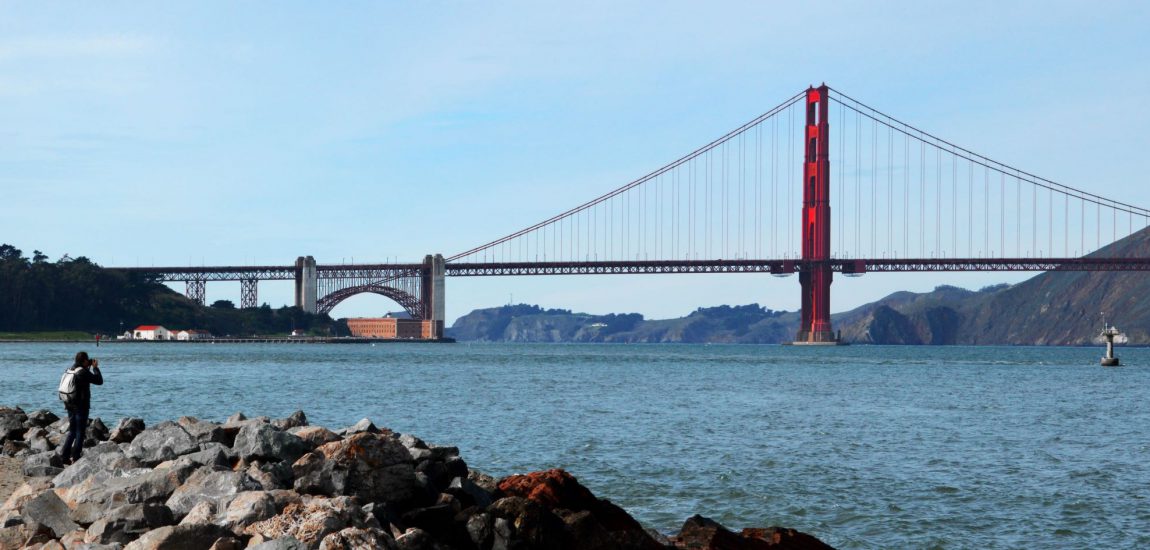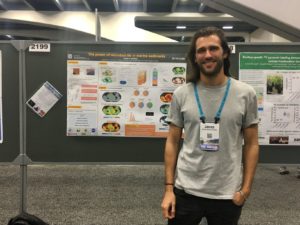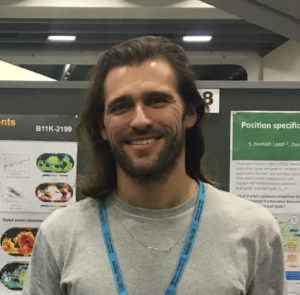
AGU Fall Meeting 2019: James Bradley

Every year, the American Geophysical Union presents its flagship meeting, the AGU Fall Meeting – the largest international Earth and space science meeting in the world, with more than 25,000 attendees. Thanks to the generous support of the EAG Early Career Science Ambassador program, I was able to attend this meeting.
The sheer size of this meeting can be overwhelming, and some pre-planning can go a long way, as AGU offers an opportunity not only to experience cutting edge science and meet lots of new people, but also to re-connect with past colleagues and collaborators. Even before arriving in San Francisco, my schedule was looking packed.
Bright and early on Monday morning, I presented my poster: ‘The power of microbial life in marine sediments’ – for which I used numerical models to quantify the energy regime of microbes buried in marine sediments. I had a number of great interactions during this poster session which gave me some ideas of where to take this work next.
The following couple of days were filled with interesting talks and posters, reunions and parties (including the infamous International Geobiology Course annual celebration), and numerous side-meetings to discuss ongoing and future collaborations, grant proposals, and fieldwork plans. AGU is a great place for these types of very important and valuable side-activities because so many people from various research groups are in attendance. I found Twitter and the official AGU app to be incredibly useful in coordinating my schedule and meetings. Because of the sheer size of the meeting, you can’t really rely on bumping into someone, like you would at a smaller conference. However, saying that, if your research interests align, there is a good chance you will find them sitting in the same session as you.
This year, I organized and convened a session for the first time. This was a very valuable experience to me professionally, as I had the opportunity to interact on many levels with scientists from all over the world before and during the meeting, and make decisions on scheduling and placement of abstracts. The session was focussed on subsurface life and biogeochemical cycles. Talks were scheduled for Thursday, and the posters were on Friday. My two original co-conveners were not attending the meeting, but thankfully Andrew Steen – a friend and collaborator from the University of Tennessee, Knoxville, stepped in to co-convene. The session was a great success, with very diverse talks on microbes in Antarctica’s subglacial lakes to deep within Earth’s oceanic crust. There were stimulating questions from the audience, and a last-minute cancellation led to an impromptu opportunity for presenters (poster and non-poster) to stand up and introduce themselves and their research interests.
Overall, the AGU Fall Meeting was incredibly worthwhile and enjoyable, and I am immensely grateful to the EAG for selecting me as their Early Career Science Ambassador. I would certainly recommend the AGU Fall Meeting to early career scientists. However, be prepared for an overwhelming number of people, talks and posters. My advice would be to be realistic about managing your schedule. I found it better to select a relevant or interesting session and stick with it, rather than rushing between the three large venues to hear individual talks. Also, with such a diversity of science on offer, make sure you dive into at least a few sessions/talks/posters that you wouldn’t otherwise! Lastly, San Francisco is a great city, so make sure you explore the wonderful restaurants, breweries, and sights around the city (not limited to downtown!) And don’t forget to bring a rain jacket!
About the author
James Bradley is a newly appointed Lecturer (Assistant-Professor) at Queen Mary University of London. He is a geomicrobiologist and Earth System modeller, and uses a range of theoretical and experimental tools to understand and quantify the activity of microorganisms and their role in driving biogeochemical cycles. His work is often centred on extreme environments including the Polar regions and the deep ocean. James is currently working on a number of projects that include measuring the activity of microbes in Arctic soils and permafrost, understanding the survival of microbes on ice sheet surfaces, and quantifying the energy-regime of microbes buried in ancient marine sediments.

